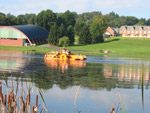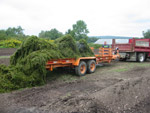Posted on Sunday, October 1, 2006
The word "harvest" usually means that we are taking the fruit, seeds or other parts of plants that will provide food or in some other way enrich our lives. We also harvest pondweed from Brittain Lake on Westminster's campus, not as a direct food but as a way to control overgrowth of an invasive plant, the Eurasian milfoil. This pondweed is native to Europe, Asia and northern Africa. It was introduced to the U.S. in the 1940s although the source of the original introduction is unclear. Now Eurasian milfoil occurs in nearly every state in the U.S. In the past it was sometimes sold as an aquarium plant by pet stores. Milfoil is a flowering plant. It sends tiny clusters of flowers above the water level for pollination. And this isn't the only species to make Brittain Lake look shaggy. There are other aquatic flowering plants and filamentous algae to contend with.
Controlling pondweed overgrowth in a shallow lake or pond is not easy. Warm temperatures and nutrient run-off from the adjacent land make optimal growth conditions! Brittain Lake (actually a pond with a name) is about 20 acres and has a maximum depth of less than 14 feet. As an alternative to herbicide-treatment, the pondweeds in Brittain Lake are mechanically harvested once or twice a year by a floating, paddlewheel "boat" with a front sickle that cuts the rooted vegetation off at the mud interface, moves the plants with a conveyor belt to a holding area and then downloads the mat of weeds onto a trailer. JEEMCO of New Wilmington has, for the past four years, been contracted by the college to do the harvesting. Before that, Ecoscientific Solutions from the central part of our state did the same thing on Brittain Lake.
What happens next to the mat of pondweeds? Here is where the Field Station comes into the picture. The trailer-loads of green milfoil and other plants are dumped into piles at the Field Station not far from the Fayette-New Wilmington Road. Water oozes out of the mats that are about 95 per cent water! The piles are moved by tractor and allowed to settle; then they are added to the compostables as "greens." That term doesn't merely come from the color. "Greens" are compostable feedstocks that are rich in nitrogen (in contrast to "browns" that are rich in carbon). Pondweed greens make good compost. They are nutrient-filled, porous, easy to handle and rather fluffy. When mixed with food wastes from the college's dining halls and community kitchens, grass clippings from the community, manure from the Little Neshannock Stables and leaves or shredded paper we have a product that in four months of weekly stirring will be ready for use. These events all take place at the Field Station. COMPOST HAPPENS is a bumper sticker on our truck. But composting doesn't "just happen," it is labor intensive!
How much pondweed do we get in one cutting? That isn't an easy question to answer. We don't weigh the trailer loads. We estimate, conservatively, that each trailer that brings in three "dumpings" from the mechanical harvester would carry ¾ of a ton of "dripping wet stuff." That means we only have to count the trailer loads to get a rough idea of the harvest yield. In contrast to the more traditional harvest, we hope the yield is low. That usually isn't the case. In a typical harvesting that lasts about a week to 10 days we compost 25 to 40 trailer loads of pondweed. That means up to 60,000 pounds of pondweeds. When about 50 per cent of the water is evaporated or sinks into the ground and microorganisms have turned organic matter into compost, we've made a batch of 30,000 pounds of usable soil -- brown gold we call it.
Two questions are frequently asked: why do we do this and what do we do with the resulting compost. The reason for this elaborate protocol (rather than simply dumping copper sulfate or a herbicide into the lake) is that we think GREEN. That means we've counted the ecological costs and benefits and concluded that mechanical harvesting is more environmentally friendly than the quick and easy method of adding chemicals that will kill off the milfoil, other pondweeds, other forms of life . . . PLUS be there as residues for a long time. Think of it this way. Chemicals added to the lake do not stay there. The overflow canal of Brittain Lake takes this water into the Little Neshannock Creek; that water joins the "Big" Neshannock Creek, Shenango River, Mahoning River to form the Beaver River that runs into the Ohio River that runs into the Mississippi River that enters the Gulf of Mexico. Along the way, our water becomes drinking water for towns and cities. Brittain Lake water carries with it whatever we (and others) have added to it. And an ecological view tells us that we "cannot do just one thing" -- we and all the life between New Wilmington and the ocean are likely to be affected by what we do and the chemicals we add! That is a sobering thought! That is a green thought.
What do we do with the compost? We process about 12 tons of compostables from all sources per month, yearlong. With a good mix of greens and browns this generates about six tons of nutritious soil per month! We use this at the Field Station to plant trees -- last spring 325 seedlings were off to a good start with compost. We landscape with compost and nourish existing trees and grass at the Field Station. Next spring, compost is likely to be used on the main campus for topdressing trees -- oaks, maples, and more. They need nutrients. The third use is very simple: we give it away! No charge! We fill garbage cans and bags. So far we don't generate enough to fill trucks! Community members give us their usable feedstocks; we give back potting soil. That is green thinking and doing.
Oh, and there might be a final question: will harvesting the lake cure the overgrowth of Eurasian milfoil? No. Neither will herbicides. The only cure is to make Brittain Lake deeper, like 25 to 30 feet for 75 per cent of the lake! Cold, deep water doesn't grow milfoil. But paying to dredge the lake is another matter, a low priority!
Clarence Harms, Director of the Field Station

